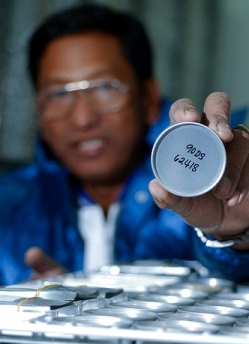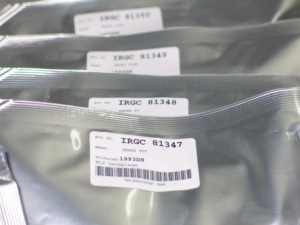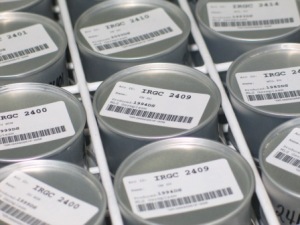Storage of cultivated rice genetic resources
Contributors to this page: T.T. Chang Genetic Resources Centre-IRRI, Los Baños, Philippines (Ruaraidh Sackville Hamilton, Ken McNally, Flora de Guzman, Renato Reaño, Soccie Almazan, Adelaida Alcantara, Elizabeth Naredo); WARDA, Cotonou, Benin (Ines Sánchez); UPLB-University of the Philippines at Los Baños (Teresita Borromeo).
|
Contents: |
When it should be used
- A base collection should be held only by a genebank with mandate and responsibility for secure long-term conservation.
- A sample of every unique accession should be stored in a base collection.
- A genebank with only an active collection and no facilities for long-term conservation should make arrangements for long-term conservation of its unique germplasm in the base collection of another suitable genebank.
-
Accessions conserved in a base collection should never be used, except:
- To regenerate seed for the base collection when viability decreases below the threshold.
- To regenerate seed for the active collection when the only available source for planting in the active collection is four generations from the original seed, or when a problem in managing the active collection has resulted in the total loss of seed from the active collection.
- For scheduled viability monitoring.
- In the event of accidental loss of all seed from the active collection.
Sample specifications
Minimum sample size for storage
- 120 g (2 cans).
Minimum viability for storage
- 85% (for some accessions even newly harvested seed has viability lower than 90%).
Moisture content
- 6-7%.
Container specifications
 Aluminium (corrosion free) can (photo: IRRI) |
Seed packaging method
- Use a specially designated seed packing, labelling and weighing room, situated adjacent to the seed drying room and with humidity reduced using a dehumidifier.
- Prepare two aluminium cans per accession (two separate cans per accession improves security and management, enabling half the accession to be kept packed in the event that it is necessary to remove seed).
- Prepare barcoded labels with the following printed information: accession number, name, crop year, Seed Lot ID, tray ID for storage and barcode. The barcode itself contains the Seed Lot ID.
-
Label each can with:
- Accession ID and crop season written on the body using permanent marking pens.
- Bar-coded label affixed to the lid.
- Small paper labels printed with accession ID and crop season, placed inside the cans.
- Arrange the cans in the packing area, in the order of taking samples out of the drying room.
- Take only a few samples at a time from the drying room (to minimize reabsorption of water during packing).
-
For each sample, find its two corresponding labelled cans and double check that all labels match.
- The label inside the cans, on the lid, outside on the body and on the packet retrieved from the drying room.
- Pour seeds into can.
- Vacuum seal in semi-automatic can sealer at 20 PSI.
- Check for deficiencies in the can: if there is any deficiency, discard and repeat labelling and packing with a new can.
- Weigh the can (tare to the weight of an empty can) and record weight in the database using the inventory management system.
Specifications of packaging material
- Aluminium (corrosion free) can volume 100 cm3 (e.g. 6 cm diameter * 3.5 cm high) to hold 60 g rice, strong enough to withstand vacuum packing.
- Air-tight and moisture-proof seal.
- Special-purpose high-quality labels created with material, adhesive and print designed to survive 100 years at 0-100% humidity and - 20°C to +30°C, e.g. from CILS International.
Storage specifications
Assigning location codes
- Label shelves and trays in the long-term cold store.
- Record in the database the number of accessions that can be accommodated on each tray.
- Using the database inventory management system to query the locations of used and unused trays, find the next available unused location in the cold store.
- Knowing the number of cans per tray, determine the tray number to be used for each accession in the batch to be packed.
- Assign that number to be printed on the label of each container (printing the tray number on the label facilitates accurate management of the store, including returning the can to the correct location).
Storage conditions
- -18 to -20°C.
 Moisture-proof laminated aluminium foil packaging for active storage (photo: IRRI) |
When it should be used
- An active collection should be maintained by a genebank with mandate and responsibility to distribute seeds to users.
-
Samples conserved in the active collection should be the normal source of seed for use, including to:
- Distribute seed to users.
- Regenerate seed for the active collection, for up to three generations from the original seed.
- All other genebank purposes, including characterization, viability testing and other genebank research activities.
Sample specifications
Minimum sample size for storage
- Sufficient to establish two plots for regeneration with a safety margin – an amount of 60 g.
Target quantity for initial storage
- Typically 0.5-1 kg depending on expected demand.
- Use a larger quantity for heavily used accessions.
- Use less quantity for rarely-used accessions.
Viability for storage
- 85% of initial viability.
Moisture content
- 6-7%.
Container specifications
Seed packaging method
- Use a specially designated seed packing, labelling and weighing room, situated adjacent to the seed drying room and with humidity reduced using a dehumidifier.
- Prepare containers (preparing ‘pre-packs’ for distribution in advance increases initial packing costs for storage but substantially reduces re-packing costs for distribution and re-storage. It is strongly advised for heavily used collections.
- For little used collections it is more effective to store only bulk samples (with a smaller than average amount than in heavily-used collections):
- Normal accessions: one large pouch for the bulk and two ‘pre-packs’ for distribution.
- Popular accessions: two large pouches for the bulk and five ‘pre-packs’ for distribution.
- Prepare barcoded labels for the bulk samples, with the following printed information: accession number, name, crop year, Seed Lot ID, tray ID for storage and barcode. The bar-code itself contains the Seed Lot ID.
- Prepare labels for the aluminium pre-packs, labelled with the same information as for the bulk sample but without a barcode.
- Prepare small samples of activated self-indicating silica gel (1 per bulk pouch) in a sealed plastic pack.
- Affix labels to the bulk and pre-packs and arrange them in the packing area in the same order in which they will be withdrawn from the drying room.
- Take only a few samples at a time from the drying room (to minimize reabsorption of water).
- For each sample, find its corresponding labelled bulk and pre-pack pouches, and double check that all labels match.
- Pour 10 g aliquots of seed into each pre-pack and seal using high temperature constant heat sealer (HM 305 CTE Constant Twin Element laminate crimp sealer, supplied by Hulme-Martin Ltd.) with 1 cm seal width.
- Pour the rest of the sample in the pouch(s) for the bulk sample.
- Perforate one packet of silica gel and place it in the foil pouch just before sealing (the silica gel serves a double purpose, to remove moisture that may have been absorbed during the packing process and to indicate cases of leakage during storage).
- Seal using the high temperature constant heat sealer.
- Check for packing deficiency.
- Reseal or replace if there is any deficiency.
- Weigh the bulk pouches and record weight in the database using the inventory management system.
Specifications of packaging material
- Moisture-proof laminated aluminium foil with wide seam on all sides (re-sealable aluminium foil is more convenient for active use with frequent re-packing than the hard aluminium cans recommended for the base collection).
- For bulk storage: use large pouches, approx 24 cm x 16 cm.
- For distribution use pre-packs: small pouches, approximately 11 cm x 8 cm. (pre-packs are small pouches containing a 10 g sample of rice pre-packed ready for use, before it is actually needed. Aluminium pre-packs are for distribution to users. Preparing them in advance substantially reduces packing and re-packing costs in a well-used genebank).
- Special-purpose high-quality labels created with material, adhesive and print designed to survive 40 years at 0-100% humidity and 2°C to +30°C, e.g. from CILS International.
- To reduce costs, lower quality labels may be used for the pre-packs.
Storage specifications
Assigning location codes
- Arrange the packed seeds side by side in a numbered tray according to accession number.
- Assign tray number corresponding to the accession number.
- Place and arrange the tray consecutively in the Active Collection room.
- For accessions without bulk samples, a temporary tray number is assigned until a bulk has been prepared.
Storage conditions
- 6-7%.
For information on safety duplication, click here.
Storage space arrangement
These practices are based on manual operations, not on robot-mediated deposits and withdrawals.
 |
Room
- Walk-in cold store, height 3-5 m, heavily insulated.
- Redundant cooling equipment with backup failover mechanism, placed outside under shade to facilitate heat exchange.
Shelf stacks
- Parallel stacks, in two rows against opposite walls with 2 m passage between rows.
- Height to about 0.5-1 m below ceiling.
- Total depth about 1 m per shelf, with racks/slots on both sides for removable trays.
- Mobile shelves mounted on wheels on tracks, with rotating handles to move the shelves, geared to facilitate easy movement even when fully loaded, to enable denser packing of the cold store.
- When positioned to maximize space between one pair of shelves, the distance between them is about 1 m, to facilitate the withdrawal of trays.
- Labelled with a shelf ID corresponding to ID used in the database.
Trays
- About 0.5 m deep (half shelf depth).
- Height enough to accommodate a single layer of seed packets with room to slide in and out.
- Labelled with a tray ID corresponding to the ID used in the database.
System for tracking material/inventory system
 |
|
Bar-coded labels (photo: IRRI) |
Preferred option: barcoded inventory
- Ideally use barcoded labels with a barcode reader and balance linked to the genebank database through a computerized inventory management system.
- For samples with the amount recorded in grams for the inventory (i.e. bulk sample for the active collection, and the sample for the base collection), before a newly-packed sample is placed in storage, and subsequently each time seed is removed from it and repacked, for whatever purpose, weigh or re-weigh the seed before replacing the sample in storage. The inventory management system will automatically update the inventory.
- For samples with the amount recorded as number of packets (i.e. aluminium pre-packs for the active collection, aluminium pre-packs for safety backup, and paper pre-packs for other immediate uses), the number of packets added or remaining is automatically updated in the inventory by the inventory management system as part of the computer-controlled processes of storing new seeds and distributing samples to users.
Alternative option: inventory management without barcodes
-
Bulk sample in active collection:
- Before a newly packed bulk sample is placed in storage, weigh it and record the weight manually in the inventory.
- Each time the bulk sample is removed to extract seed (e.g. to make new aluminium pre-packs or for direct local use), subtract the amount removed from the amount recorded in the inventory.
- Once every ten years, undertake a complete manual inventory of the active collection, to correct the errors that gradually cumulate by recording amounts removed cumulatively rather than the amount replaced in storage.
- For samples with the amount recorded as number of packets, use the same procedure as described for barcoded system.
- Base collection: record the amount as number of cans, not grams, and maintain inventory as for pre-packs.
Recording information during storage
The following information should be recorded for each step:
- Accession ID (ID of accession).
- Seed Lot ID (ID of this sample of the accession).
- Crop season (year and season the seed was harvested).
- Store type (temporary, active bulk, active pre-pack, base, primary safety backup, secondary safety backup (type of storage and packing for this sample).
- Location in storage (shelf and tray number (temporary, active, base).
- Species (O. glaberrima or O. sativa).
- Germination % (two replications) (germination % - separate values for each replication; new record for each test).
- Germination test No. (number of seeds per replicate used for testing germination %).
- Germination date (date of germination test; new record for each test).
- Seed amount units – grams, number of packets (units used to record the amount of seed of this sample).
- Seed amount (amount of seed in store; new record for each update).
- Inventory date (date the amount was last updated; new record for each update)
Comments
- No comments found





Leave your comments
Post comment as a guest